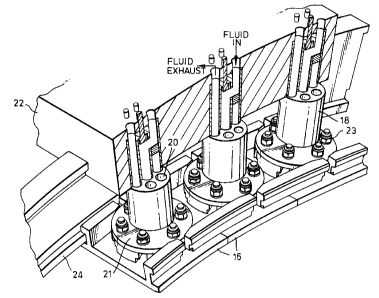Some of the information on this Web page has been provided by external sources. The Government of Canada is not responsible for the accuracy, reliability or currency of the information supplied by external sources. Users wishing to rely upon this information should consult directly with the source of the information. Content provided by external sources is not subject to official languages, privacy and accessibility requirements.
Any discrepancies in the text and image of the Claims and Abstract are due to differing posting times. Text of the Claims and Abstract are posted:
| (12) Patent: | (11) CA 2234862 |
|---|---|
| (54) English Title: | BLADE TIP CLEARANCE CONTROL APPARATUS |
| (54) French Title: | DISPOSITIF DE CONTROLE DU JEU D'EXTREMITE POUR OUTILS DE COUPE |
| Status: | Deemed expired |
| (51) International Patent Classification (IPC): |
|
|---|---|
| (72) Inventors : |
|
| (73) Owners : |
|
| (71) Applicants : |
|
| (74) Agent: | GOWLING WLG (CANADA) LLP |
| (74) Associate agent: | |
| (45) Issued: | 2007-06-19 |
| (22) Filed Date: | 1998-04-15 |
| (41) Open to Public Inspection: | 1998-10-22 |
| Examination requested: | 2003-03-03 |
| Availability of licence: | N/A |
| (25) Language of filing: | English |
| Patent Cooperation Treaty (PCT): | No |
|---|
| (30) Application Priority Data: | ||||||
|---|---|---|---|---|---|---|
|
A blade tip clearance control apparatus (10) comprises a
plurality of circumferentially arranged spaced wall members
(16) located adjacent the rotor path of a plurality of rotor
blades (14). Each wall member (16) is mounted on a carrier
(18) attached to an annular casing (22) radially outward
thereof. Thermal expansion or contraction of the carrier (18)
causes radial movement of the wall members (16). The wall
members (16) have at least one fluid passage (20) therein. In
operation a flow of fluid passing through the fluid passages
(20) causes either thermal expansion or contraction of the
wall member (16) to different radial positions.
Note: Claims are shown in the official language in which they were submitted.
Note: Descriptions are shown in the official language in which they were submitted.

For a clearer understanding of the status of the application/patent presented on this page, the site Disclaimer , as well as the definitions for Patent , Administrative Status , Maintenance Fee and Payment History should be consulted.
| Title | Date |
|---|---|
| Forecasted Issue Date | 2007-06-19 |
| (22) Filed | 1998-04-15 |
| (41) Open to Public Inspection | 1998-10-22 |
| Examination Requested | 2003-03-03 |
| (45) Issued | 2007-06-19 |
| Deemed Expired | 2011-04-15 |
There is no abandonment history.
| Fee Type | Anniversary Year | Due Date | Amount Paid | Paid Date |
|---|---|---|---|---|
| Registration of a document - section 124 | $100.00 | 1998-04-15 | ||
| Application Fee | $300.00 | 1998-04-15 | ||
| Maintenance Fee - Application - New Act | 2 | 2000-04-17 | $100.00 | 2000-03-24 |
| Maintenance Fee - Application - New Act | 3 | 2001-04-16 | $100.00 | 2001-03-28 |
| Maintenance Fee - Application - New Act | 4 | 2002-04-15 | $100.00 | 2002-03-28 |
| Request for Examination | $400.00 | 2003-03-03 | ||
| Maintenance Fee - Application - New Act | 5 | 2003-04-15 | $150.00 | 2003-03-14 |
| Maintenance Fee - Application - New Act | 6 | 2004-04-15 | $200.00 | 2004-03-25 |
| Maintenance Fee - Application - New Act | 7 | 2005-04-15 | $200.00 | 2005-03-24 |
| Maintenance Fee - Application - New Act | 8 | 2006-04-17 | $200.00 | 2006-03-20 |
| Final Fee | $300.00 | 2007-02-02 | ||
| Maintenance Fee - Application - New Act | 9 | 2007-04-16 | $200.00 | 2007-03-21 |
| Maintenance Fee - Patent - New Act | 10 | 2008-04-15 | $250.00 | 2008-03-17 |
| Maintenance Fee - Patent - New Act | 11 | 2009-04-15 | $250.00 | 2009-04-02 |
Note: Records showing the ownership history in alphabetical order.
| Current Owners on Record |
|---|
| ROLLS-ROYCE PLC |
| Past Owners on Record |
|---|
| OWEN, BRIAN CHARLES |